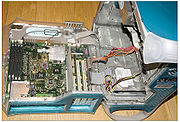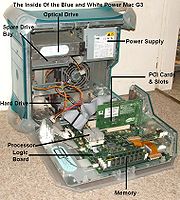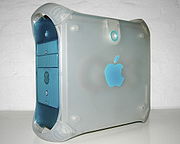.gif)
Power Macintosh G3 (Blue & White)
Encyclopedia

Power Macintosh G3
The Power Macintosh G3, commonly called "beige G3s" or "platinum G3s" for the color of their cases, was a series of personal computers designed, manufactured, and sold by Apple Computer, Inc. from November 1997 to January 1999...
) was a series of personal computers designed, manufactured and sold by Apple Computer Inc. as part of their Power Macintosh
Power Macintosh
Power Macintosh, later Power Mac, was a line of Apple Macintosh workstation-class personal computers based on various models of PowerPC microprocessors that were developed, marketed, and supported by Apple Inc. from March 1994 until August 2006. The first models were the Power Macintosh 6100,...
line. It was introduced in January 1999, succeeding the original "beige" Power Macintosh G3
Power Macintosh G3
The Power Macintosh G3, commonly called "beige G3s" or "platinum G3s" for the color of their cases, was a series of personal computers designed, manufactured, and sold by Apple Computer, Inc. from November 1997 to January 1999...
, with which it shared the name and processor architecture but little else; it was discontinued in favor of the Power Mac G4
Power Mac G4
The Power Mac G4 was a series of personal computers that was designed, manufactured, and sold by Apple between 1999 and 2004. They used the PowerPC G4 series of microprocessors. They were heralded by Apple to be the first personal supercomputers, reaching speeds of 4 to 20 Gigaflops...
line in August 1999.
The Blue & White G3 used a modified version of the memory/PCI controller, the Motorola MPC106 (codenamed "Grackle"); it used the MPC106 v4. The I/O "Heathrow" had been replaced by "Paddington" (adding 100 Mbit Ethernet and power save features), the audio chip "Screamer" (on the beige G3's "Personality Card") had been replaced by "Burgundy", and other controllers for Firewire (Texas Instruments PCI-Lynx), for USB etc. were added.
Note that "Paddington" only handles the slow IDE bus for CD/DVD and ZIP, in fact it provides up to 16.6 MB/s like its predecessor "Heathrow". The fast IDE bus for the hard disks is an extra chip and provides up to 33 MB/s; this one is the problem in the Rev 1 blue/white G3s.
Though still based on the PowerPC G3
PowerPC G3
The PowerPC 7xx is a family of third generation 32-bit PowerPC microprocessors designed and manufactured by IBM and Motorola . This family is called the PowerPC G3 by its well-known customer Apple Computer...
architecture, the G3 B&W was a totally new design. The first new Power Mac model after the release of the iMac
IMac
The iMac is a range of all-in-one Macintosh desktop computers built by Apple. It has been the primary part of Apple's consumer desktop offerings since its introduction in 1998, and has evolved through five distinct forms....
, it used a novel enclosure with the logic board on the folding "door", which swung down onto the desk for easy access (a design that was also used on all Power Mac G4
Power Mac G4
The Power Mac G4 was a series of personal computers that was designed, manufactured, and sold by Apple between 1999 and 2004. They used the PowerPC G4 series of microprocessors. They were heralded by Apple to be the first personal supercomputers, reaching speeds of 4 to 20 Gigaflops...
models except for the Cube
Power Mac G4 Cube
The Power Mac G4 Cube was a small form factor Macintosh personal computer from Apple Inc. It was sold from 2000 to 2001. Its cube shape is reminiscent of the NeXTcube from NeXT, acquired by Apple in 1996. The machine was designed by Apple industrial designer Jonathan Ive...
). It also introduced the New World ROM
New World ROM
New World ROM computers are Macintosh models that do not use a Macintosh Toolbox ROM on the logic board. Due to Mac OS X not requiring the availability of the Toolbox, this allowed ROM sizes to shrink dramatically , and facilitated the use of Flash memory for system firmware instead of the now more...
to the Power Macintosh line.
Hardware
The faster models (not the 300 MHz model) used the new copper-basedCopper-based chips
Copper-based chips are semiconductor integrated circuits, usually microprocessors, which use copper for interconnections. Since copper is a better conductor than aluminium, chips using this technology can have smaller metal components, and use less energy to pass electricity through them...
PowerPC G3 CPUs made by IBM
IBM
International Business Machines Corporation or IBM is an American multinational technology and consulting corporation headquartered in Armonk, New York, United States. IBM manufactures and sells computer hardware and software, and it offers infrastructure, hosting and consulting services in areas...
, which used about 25% of the power of the Motorola versions clock for clock. The B&W line ranged from 300 to 450 MHz. Despite its 100 MHz system bus and PC100 SDRAM, the 300 MHz B&W G3 performed worse than its 300 MHz Beige predecessor, because it had only 512 KB L2 cache, half of what the 300 MHz Beige had. The logic board had four PCI slots: three 64-bit 33 MHz slots, and one 32-bit 66 MHz slot dedicated for the graphics card, an ATI Rage 128 with 16 MB SGRAM
Dynamic random access memory
Dynamic random-access memory is a type of random-access memory that stores each bit of data in a separate capacitor within an integrated circuit. The capacitor can be either charged or discharged; these two states are taken to represent the two values of a bit, conventionally called 0 and 1...
. Four 100 MHz RAM slots accepted PC100 SDRAM modules, allowing the installation of up to 1 GB of RAM with the use of 256 MB DIMMs. The onboard ATA was upgraded to Ultra ATA/33 (in fact an extra UDMA-33 controller was added, see above), but SCSI was no longer present, having been replaced by two FireWire ports, a new standard (IEEE1394) running at 400 Mbit/s (50 MB/s) — faster in theory than even the ATA/33 (33 MB/s) hard drive controller. The serial port
Serial port
In computing, a serial port is a serial communication physical interface through which information transfers in or out one bit at a time...
s were gone, too, having given way to two USB
Universal Serial Bus
USB is an industry standard developed in the mid-1990s that defines the cables, connectors and protocols used in a bus for connection, communication and power supply between computers and electronic devices....
1.1 ports (12 Mbit/s), as implemented already in the iMac. The ADB
Apple Desktop Bus
Apple Desktop Bus is an obsolete bit-serial computer bus connecting low-speed devices to computers. Used primarily on the Macintosh platform, ADB equipment is still available but not supported by most Apple hardware manufactured since 1999....
port remained, as did the option for an internal modem. Also gone was the internal floppy disk drive. 100BASE-TX Ethernet was now standard, and audio was moved back to the logic board. A Zip Drive remained an option, and some configurations included a DVD-ROM drive and a DVD-Video decoder daughtercard
Daughterboard
A daughterboard, daughtercard or piggyback board is a circuit board meant to be an extension or "daughter" of a motherboard , or occasionally of another card...
for the graphics card, allowing hardware-assisted DVD video playback.
The blue-and-white Power Macintosh G3 was the first Power Mac with the "New World" architecture which only contained a small (approximately 1 MB) boot ROM. When booting the Mac OS, the Mac OS Toolbox and any other ROM patches installed would be loaded into RAM (the former Beige G3 however was the first Mac with this ROM-in-RAM capability). Initially, many buyers chose to buy the older "Platinum" G3s instead, in order to maintain compatibility with existing peripherals.
The blue and white G3's case design was widely praised at the time for being easy to open up and work on. It had a door on the side that hinged down by pulling a latch at the top. No components needed to be removed or unplugged to open the case, and in fact it could be done with the computer running. The logic board
Logic board
A logic board is the Apple equivalent of a motherboard. The term logic board was coined back in the 1980s, when the compact Macs at the time had two separate circuit components. The term "logic board" stuck over the years of Macintosh manufacturing, even in the non-all-in-one Macs...
was positioned in the door, providing easy access to all components. The hard drive(s) were mounted in a bracket affixed with one screw on the floor of the case. There was room for four internal hard drives. Removable drives were in a more conventional position at the top of the case.


The secondary ATA channel has also been reported to have issues with respect to flash upgrading certain DVD burners. Otherwise, it is generally held to be relatively stable.
Mac OS X attempts to avoid the UDMA issue by disabling UDMA on all affected G3 motherboards, but xlr8yourmac.com reported that reader Tim Seufert still found issues with single drives under Mac OS X. He reported that as of January 23, 2002, the fix would not be activated under Mac OS X when no slave drive was present.
The "Revision 2" units fixed the hard drive controller problem with an improved (UDMA-33) IDE controller that supported the standard IDE master/slave two-drive arrangement. This controller worked flawlessly with any drive within the 28-bit LBA constraint. Most Rev. 2 units shipped with a hard disk bracket designed for two drives (in fact Rev. 1 can hold up to three drives side-by-side, while Rev. 2 can hold up to four drives in two stacks, each with two drives) and also included a slightly updated version of the Rage 128 graphics card. The easiest way to tell if the unit is a Rev.2 is by looking at the CMD chip located on the logic board. The CMD chip on Rev. 1 logic boards is PCI646U2 and on Rev. 2 logic boards is 646U2-402.
Revision B 350, 400 and 450 MHz units use the same motherboard as the first "Yikes" version of Power Mac G4
Power Mac G4
The Power Mac G4 was a series of personal computers that was designed, manufactured, and sold by Apple between 1999 and 2004. They used the PowerPC G4 series of microprocessors. They were heralded by Apple to be the first personal supercomputers, reaching speeds of 4 to 20 Gigaflops...
systems at 350 and 400 MHz ("Sawtooth" AGP-based G4s used a different board) and processor cards for these models are interchangeable. Note that if a G3's firmware has been upgraded (a required update for installing Mac OS 9), it won't accept G4 CPUs until patched with a third-party replacement firmware.
Operating System
The first Blue & White G3s shipped with Mac OS 8.5.1, while later revisions shipped with 8.6. The latest version of Mac OS that can be run on this model is Mac OS X 10.4 Tiger (current version: 10.4.11), as Mac OS X 10.5 Leopard discontinued support for G3 processors - although it is possible to run Leopard if the processor is upgraded to a G4 and several additional kexts are installed from Tiger or beta releases of Leopard.Models
| Component | Power Mac G3 | |
|---|---|---|
| Model | January 1999 | June 1999 (Rev. B) |
| Model #s | M6670LL/A (300 MHz), M6668LL/A or M6666LL/A (350 MHz), M6665LL/A (400 MHz) | M7556LL/A (350 MHz Rev. B), M7555LL/A or M7554LL/A (400 MHz Rev. B), M7553LL/A (450 MHz Rev. B) |
| Graphics Card | ATI Rage 128 GL with 16 MB of SDRAM graphics memory | |
| Hard drive | 6 GB, 9 GB, 12 GB, 20 GB, or 27 GB Ultra ATA hard disk drive Upgradable to 128 GB |
|
| Processor Central processing unit The central processing unit is the portion of a computer system that carries out the instructions of a computer program, to perform the basic arithmetical, logical, and input/output operations of the system. The CPU plays a role somewhat analogous to the brain in the computer. The term has been in... |
300 MHz PowerPC G3 with 64 KB on-chip L1 cache and 512 KB on-chip L2 cache, or 350 MHz or 400 MHz PowerPC G3 with 64 KB on-chip L1 cache and 1 MB on-chip L2 cache | 350 MHz, 400 MHz, or 450 MHz PowerPC G3 with 1 MB on-chip L2 cache |
| Memory | 64 MB or 128 MB of unbuffered 100 MHz PC-100 SDRAM Upgradable to 1 GB |
|
| Optical Drive | 24x or 32x CD-ROM, 5x DVD-ROM drive Optional Zip 100 drive |
|
| Included Operating System | Mac OS 8.5.1 Mac OS 8 Mac OS 8 is an operating system that was released by Apple Computer on July 26, 1997. It represented the largest overhaul of the Mac OS since the release of System 7, some six years previously. It puts more emphasis on color than previous operating systems... |
|
| Maximum Operating System | Mac OS X 10.4.11 Unofficially, can run Mac OS X Leopard with a PowerPC G4 CPU upgrade. |
|
| Dimensions | 27.8 lb (13 kg), 17" H × 8.9" W × 18.4" D (432×226×467 mm) | |
Sources
- Power Macintosh G3 (Blue & White):Technical Specifications on apple.com
- Developer Note Apple's internal description
- Power Macintosh G3 (Blue & White) on apple-history.com
- Power Macintosh G3 (Blue & White) on EveryMac.com
- Power Macintosh G3 (Blue & White) on Low End Mac
- http://forum.rpc1.org/viewtopic.php?t=36495 Flash upgrading of Pioneer drives on secondary ATA channel issues (forum)

